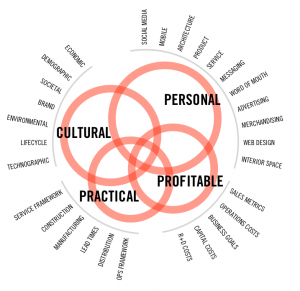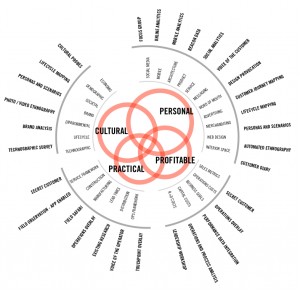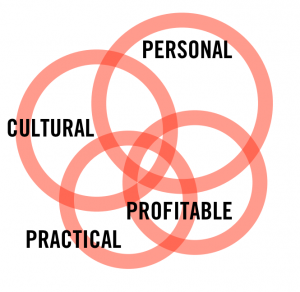BETTER RESEARCH MAKES BETTER BUSINESS
For any customer experience initiative to be successful, the project team needs to be very well informed about the customer’s preferences, opinions and behaviors – while the customer is engaged with a complex network of channels, environments, touchpoints and media. That’s a lot of moving parts, and a lot of different interests to keep in check.
It never ceases to amaze us how much there is to discover when we embark on a new CX project. Many ideas that seemed to be “givens” dissolve the moment we get into the field and start talking to people. Over the years, we have developed a working set of tools that help us get a better understanding of the customer. It’s unlikely that you would ever use them all on a single project, so knowing how each tool can extend your capabilities to understand the customer is key to framing up a project.
Before getting into the toolbox, we need to start by asking what aspects of the customer’s experience we want to examine, and what the scope of the project will be…..
FOUR CONDITIONS
From what we’ve seen there are four conditions that need to be satisfied to foster a customer experience that is mutually beneficial to the customer and the company.
Personal. The customer will be giving their time and their money in exchange for a product, service and experience – they deserve and expect to be engaged in a way that is relevant and valuable to them.
Practical. The company needs to be able to effectively operationalize the approach in the real world.
Profitable. The balance between operations costs and sales needs to be positive and worthwhile.
Cultural. For the customer, the experience needs to be appropriate for their cultural framework and how they see themselves in it. From the company’s point of view, the aggregate of all these experiences makes up the building blocks of their brand and it’s place in the world.
When a customer interacts with a brand, each aspect of their experience is modified through different touchpoints, media and channels. Each of these can be extremely complex in themselves, can overlap each other, and are generally managed by large diverse groups within a company. These groups are often siloed into isolated management structures, with a lack of communication between each other. When a single tactic aimed at fostering a positive customer experience requires a holistic approach to be successful, many management teams are unable to get a complete view of the terrain.

Please click the picture for a closer look.
The CX Toolbox – the components of which are shown here in the outer ring – is a set of processes and tools aimed at giving a company a better understanding of how it connects with their customers in the real world, the experiences that customers are having as a result, and how all of this relates to business goals and profit for the company. (A deep dive into individual research methods, their strengths and limitations can be found here.) This set of tools will always be evolving and incomplete – adapting to the needs of the broader field of CX.

Please click the picture for a closer look.
The CX Toolbox splits nicely into six toolsets – each one with a different area of focus:
1. THE EXISTING INTELLIGENCE TOOLSET helps integrate the knowledge that is already embedded in the company into the Discovery Phase of a CX research project. Every company has a set of prior learnings, colloquial knowledge, existing research and financial data that can provide context and key insights for understanding how the company currently connects with it’s customers. These tools can also be used to bring stakeholders into the conversation that otherwise would not be heard.
STAKEHOLDER WORKSHOP
LIVE DATA INTEGRATION
EXISTING RESEARCH INTEGRATION
BRAND AUDIT
SEGMENTS, PERSONAS AND SCENARIOS
2. THE CUSTOMER INPUT TOOLSET incorporates the customer’s point of view into the Discovery Phase of a CX design project. As with any survey design, the answers will only be as good as the questions. The quality of the data will be dependent on the sensitivity of the researcher not just to the experience of the customer generally, but also their experience of the survey.
VOICE OF THE CUSTOMER
VOICE OF THE OPERATOR
FOCUS GROUP
WEB FORUM
CUSTOMER DIARIES OR PROBES (MOBILE AND ANALOG)
PARTICIPATORY EXPERIENCE DESIGN
3. THE FIELD RESEARCH TOOLSET is used to build a rich set of observations about customer behavior for use in the Discovery Phase of a CX project. Most of these techniques are derived from the social sciences. The term “ethnography” comes from the late 19th century, when Western researchers interested in the cultures of indigenous peoples found that they could only understand their subjects if they made observations up close – observing behavior and interaction in the real world rather than basing their research on hearsay or conjecture. This thinking has been adopted into the field of Customer Experience, with teams of researchers being dispatched to watch customers in the field, hopefully without significantly altering the terrain as they make their observations. While these techniques were originally developed for the physical environment, they have been adapted to call centers, online and other service areas.
ETHNOGRAPHIC RESEARCH
PHOTO / VIDEO ETHNOGRAPHY
FIELD SAFARI
SECRET CUSTOMER
FIELD OBSERVATION – MOBILE ENABLED
4. THE ANALYTICS TOOLSET analyses information collected from digital sources and ethnographic research during the Discovery Phase of a project – identifying correlations in the data to help guide business initiatives. For a deeper dive in this area, see our article “The Phygital Customer” available here.
ONLINE ANALYTICS
SOCIAL ANALYTICS
BEACON DATA
AUTOMATED ETHNOGRAPHY AND ANALYTICS
MOBILE ANALYTICS
5. THE VISUALIZATION TOOLSET helps CX research teams during the Discovery and Ideation Phases find patterns in customer behavior by creating images from the research data. For a deeper dive into customer journey mapping and related techniques, visit lenati.com/cx.
CUSTOMER JOURNEY MAPPING
PERCEPTIONS AND EXPECTATIONS OVERLAY
TOUCHPOINT / AFFORDANCES OVERLAY
OPERATIONS OVERLAY (STAKEHOLDER MAP)
LIFECYCLE MAPPING
CUSTOM DATA VIZ
OPERATIONS AND PROCESS ANALYSIS
6. THE DESIGN RESEARCH TOOLSET provides techniques for validating CX concepts during the Prototype / Testing phase of a CX project. The toolset below is arranged in order of cost, from the lowest to the highest. This is usually the same order in which these tools are employed – testing more ideas faster and cheaper at the beginning and testing the more refined ideas using more accurate methods later in the process after the first ideas were weeded out. In fact, the first few tools are commonly used in the previous Ideation Phase of a project to inform the team about their ideas as they work.
LAB SIMULATION
ROLEPLAY
PROTOTYPE INTERVENTION
SOFT PROTOTYPING
PAPER PROTOTYPING
MECHANICAL TURK PROTOTYPING
FIELD PROTOTYPING
ALPHA AND BETA TESTING
AFTERWORD: PEOPLE > TOOLS
While these toolsets can be extremely powerful in the hands of an experienced research and design team, it’s important to remember that they are only a means to an end. Their value lies in how much they help build an understanding of the customer. There has been a lot of attention paid to “big data” as customer insights have become more and more data-heavy. Our analytical capacity has exploded in the last few years. It has a lot of potential upside for business, and in turn that has had a lot of press. With all that attention, we need to guard against the allure and the power of the tools themselves overwhelming our industry and relegating something as broad-reaching as “Customer Experience” to some kind of digitally-enabled game of numbers.
But overall my concern is outweighed by my optimism, fueled by the potential I’ve seen in these tools to foster better design, better business practices, and stronger connections with people.
For a deep dive into individual research methods, their strengths and limitations, please download our full-version of this article here. Or, download this piece as a part of the larger anthology THE ART AND SCIENCE OF CUSTOMER EXPERIENCE – Lenati’s comprehensive look at the rapidly-evolving field of CX. It includes articles on state-of-the-art research methods, design thinking, business case studies, omnichannel strategy, digital marketing and analytics & measurement tools and many more. Download your free copy here.
REFERENCES AND FURTHER READING
The research methods discussed in this article are in use across the fields of CX, design, customer insights and marketing. However, the language used to describe these methods is often not consistent from firm to firm.
Research for this article included:
This is Service Design Thinking.
Stickdorn and Schneider. Wiley Press
Design Research
Brenda Laurel, Editor. MIT Press.
Visualizing Complexity.
Manuel Lima, Princeton Architectural Press.
Massive Change.
Bruce Mau & Institute Without Boundaries, Phaidon.
Why We Buy – The Science of Shopping.
Paco Underhill, Simon and Schuster.




